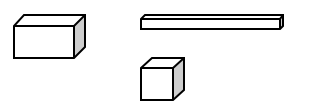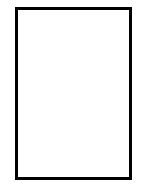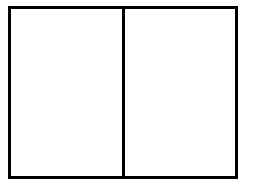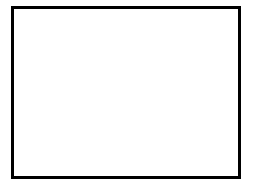Skip over navigation
Well, we're often wrapping up presents - I find that many of them arrive in boxes that are cuboid. Remember those? A cuboid has 6 faces; each face a rectangle (including squares); each face paired with one the same on the opposite side and all the angles 90 degrees. So they might look like these:

Now let's talk about the wrapping paper. You are probably used to using A4 paper for all kinds of things. A4 paper looks a bit like this:

But two A4s together make A3:

So we have:

Which could look better as:

Now for easiness we'll approximate the size of the A3 sheet to 40cm by 30cm.
The wrapping paper we'll be using is A3-size, like the picture above.
So, we're wrapping up a cuboid in this A3 wrapping paper.
The challenge is to find the largest cuboid that can be covered completely with the A3 sheet - you will probably want to stick to whole numbers of centimetres!
Rather than wrapping the cuboid like we might do a birthday present, let's think about it as if we're trying to have as little overlap as possible.
You might do this practically or you may use diagrams or even a spreadsheet - it is up to you.
Points that may well be discussed include:
1/ What determines the size of a cuboid? Surface area? Length? Volume?You could ask the group to investigate all of these, either by each group concentrating on a particular definition of "largest", or through all of them investigating each definition.
2/ Does it matter where on the A3 sheet the cuboid is placed? Does it have to be parallel to an edge to get the biggest cuboid? We would suggest that at first you limit the children to investigating only nets which are parallel to the paper's edges.
3/ If there is an overlap of paper, what size is it?
if the paper were A4 or A2?
if the paper was square e.g. 40 by 40, or 30 by 30?
if we were wrapping up balls, spheres?
if we were to cut the paper into two to wrap up two cuboids, which might be the same or different.
if . . . . . . .


Or search by topic
Number and algebra
Geometry and measure
Probability and statistics
Working mathematically
Advanced mathematics
For younger learners
All Wrapped Up
Age 7 to 11
Challenge Level 





- Problem
- Getting Started
- Student Solutions
- Teachers' Resources
All Wrapped Up
Well, we're often wrapping up presents - I find that many of them arrive in boxes that are cuboid. Remember those? A cuboid has 6 faces; each face a rectangle (including squares); each face paired with one the same on the opposite side and all the angles 90 degrees. So they might look like these:

Now let's talk about the wrapping paper. You are probably used to using A4 paper for all kinds of things. A4 paper looks a bit like this:

But two A4s together make A3:

So we have:

Which could look better as:

Now for easiness we'll approximate the size of the A3 sheet to 40cm by 30cm.
The wrapping paper we'll be using is A3-size, like the picture above.
So, we're wrapping up a cuboid in this A3 wrapping paper.
The challenge is to find the largest cuboid that can be covered completely with the A3 sheet - you will probably want to stick to whole numbers of centimetres!
Rather than wrapping the cuboid like we might do a birthday present, let's think about it as if we're trying to have as little overlap as possible.
You might do this practically or you may use diagrams or even a spreadsheet - it is up to you.
Why do this problem?
This is a challenging problem, but suits a variety of working styles.Possible approach
Some pupils will need to use practical equipment. Others will be able to draw nets and think about the relationship between the width, height and length of the cuboid compared with the dimensions of the paper. Others will want to use a spreadsheet to find all the different possibilities.Points that may well be discussed include:
1/ What determines the size of a cuboid? Surface area? Length? Volume?You could ask the group to investigate all of these, either by each group concentrating on a particular definition of "largest", or through all of them investigating each definition.
2/ Does it matter where on the A3 sheet the cuboid is placed? Does it have to be parallel to an edge to get the biggest cuboid? We would suggest that at first you limit the children to investigating only nets which are parallel to the paper's edges.
3/ If there is an overlap of paper, what size is it?
Key questions
Possible extension
Extension work may stem from asking, "I wonder what would happen if . . . ?"if the paper were A4 or A2?
if the paper was square e.g. 40 by 40, or 30 by 30?
if we were wrapping up balls, spheres?
if we were to cut the paper into two to wrap up two cuboids, which might be the same or different.
if . . . . . . .
Possible support
You may also like
The Big Cheese
Investigate the area of 'slices' cut off this cube of cheese. What would happen if you had different-sized block of cheese to start with?
Wrapping Presents
Choose a box and work out the smallest rectangle of paper needed to wrap it so that it is completely covered.

